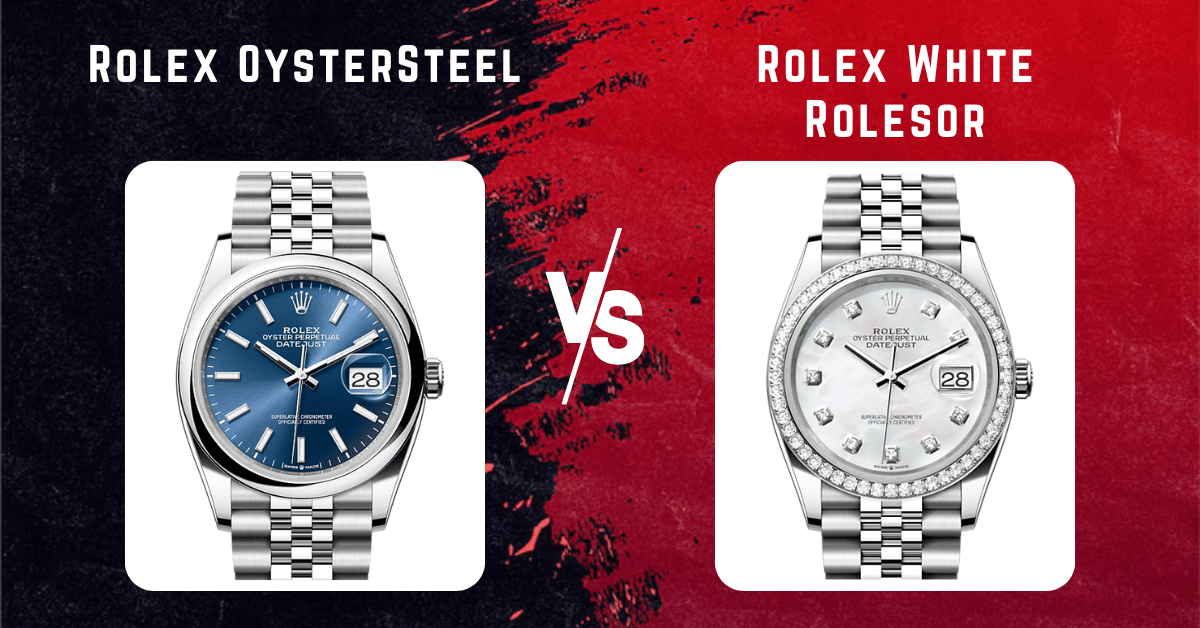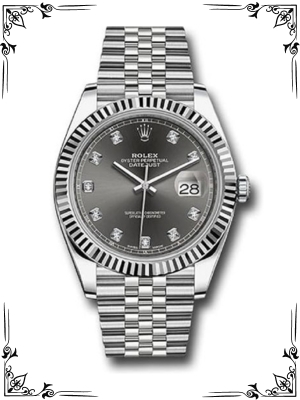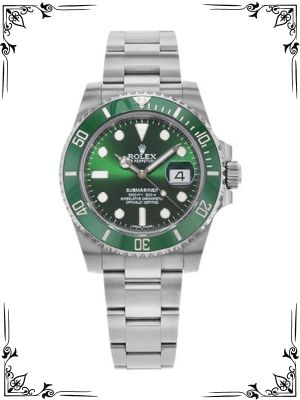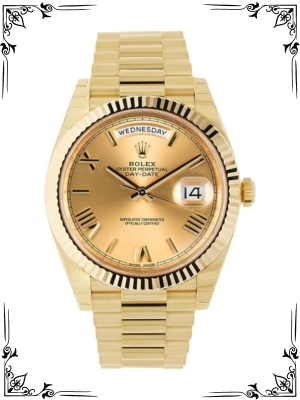OysterSteel is the robust and reliable stainless steel used in the majority of Rolex watches. It offers exceptional corrosion resistance, a high-polish finish, and timeless elegance. White Rolesor, on the other hand, is a sophisticated blend of 904L Oystersteel and 18k white gold. This combination injects a touch of luxury with the white gold bezel and sometimes the center links of the bracelet while retaining the core strength and functionality of Oystersteel.
Introduction
Hey there, watch enthusiast! Choosing the perfect Rolex can be a thrilling yet daunting task. With a plethora of options available, even seemingly minor details can have a significant impact on the overall aesthetic and value proposition.
Today, we’ll delve into the world of Rolex OysterSteel and Rolex White Rolesor, two distinct material configurations that define the look and feel of your Rolex timepiece. Buckle up, because we’re about to embark on a journey to understand the essence of these two titans of luxury.
Exploring the History
Rolex has a long and illustrious history of pioneering watchmaking advancements. In 1930, they unveiled the revolutionary Oyster case, the world’s first commercially available waterproof wristwatch. This innovation paved the way for the development of 904L Oystersteel in the late 20th century.
This خاص (khaas – Arabic for “special”) steel boasts superior corrosion resistance compared to standard stainless steel, making it ideal for Rolex’s professional-grade diving watches.
The concept of Rolesor, the marriage of gold and steel, dates back to the early 1930s as well. It embodied the perfect synergy of luxury and functionality, catering to those who craved a touch of opulence without compromising on the robustness of a tool watch.
Unveiling the Technical Nuances
Now, let’s dissect the technical aspects of OysterSteel and White Rolesor to understand their key differences:
Movement
The good news is, that both OysterSteel and White Rolesor Rolex models utilize the brand’s renowned in-house movements. These movements are renowned for their exceptional accuracy, reliability, and power reserve. Whether you choose OysterSteel or White Rolesor, you’re guaranteed a timekeeping powerhouse under the hood.
Materials and Construction
This is where things get interesting. Here’s a breakdown:
| Feature | OysterSteel | White Rolesor |
|---|---|---|
| Case Material | 904L Oystersteel | 904L Oystersteel |
| Bezel Material | 904L Oystersteel or Everose gold (depending on model) | 18k white gold |
| Bracelet Material | 904L Oystersteel | 904L Oystersteel with some models featuring 18k white gold center links |
| Clasp Material | 904L Oystersteel with a Rolex-engraved clasp | 904L Oystersteel with a Rolex-engraved clasp |
| Crystal Material | Sapphire crystal with anti-reflective coating | Sapphire crystal with anti-reflective coating |
Functions and Features
Both OysterSteel and White Rolesor configurations encompass a wide range of Rolex models, offering a variety of functions and features. These can include date complications, chronographs, GMT functionality for displaying multiple time zones, and even dive bezels for underwater exploration.
The specific features will depend on the particular Rolex model you choose.
Stay tuned for the next section, where we’ll delve into the world of design and aesthetics!
Design and Aesthetics
When it comes to choosing between OysterSteel and White Rolesor, aesthetics play a crucial role. Let’s explore the design elements that differentiate these two configurations:
Dial Design
Rolex offers a diverse range of dial colors and configurations across both OysterSteel and White Rolesor models. From classic black and white to vibrant blue and green, the dial selection caters to a variety of tastes. However, some models, particularly professional diving watches like the Sea-Dweller, might exclusively come in black for optimal legibility underwater.
Case and Bracelet
This is where the true distinction between OysterSteel and White Rolesor lies. OysterSteel models offer a uniform, sleek look with the entire case and bracelet crafted from the same polished stainless steel. This creates a sense of understated elegance and timeless sophistication.
White Rolesor, on the other hand, injects a touch of luxury with the introduction of 18k white gold. The most prominent difference is the bezel, which is crafted entirely from white gold in most White Rolesor models.
This creates a striking contrast with the Oystersteel case and bracelet, adding a touch of visual intrigue. Additionally, some White Rolesor models, like specific iterations of the Datejust and Day-Date, feature 18k white gold center links on the bracelet, further elevating the luxurious aesthetic.
Brand Image
Both OysterSteel and White Rolesor models embody the core values of Rolex: prestige, durability, and timeless style. However, White Rolesor adds a subtle layer of luxury to the equation. It caters to individuals who appreciate the functionality of a Rolex tool watch but also desire a touch of opulence.
User Feedback
When making a significant investment like a Rolex, it’s wise to consider user experiences. Here’s a breakdown of what Rolex enthusiasts have to say:
OysterSteel: Praised for its durability, versatility, and classic look. Many users appreciate the low-maintenance nature of stainless steel and its ability to withstand everyday wear and tear.
White Rolesor: Appreciated for its elevated aesthetic and luxurious feel. The combination of white gold and steel is often seen as a perfect blend of practicality and opulence. However, some users express concerns about the potential for white gold to show scratches more readily compared to stainless steel.
Common Problems
While both OysterSteel and White Rolesor are built to last, it’s essential to be aware of potential issues:
OysterSteel: Minor scratches are inevitable with any timepiece, but stainless steel can generally be polished out to restore its pristine condition.
White Rolesor: Since 18k white gold is softer than steel, scratches on the bezel or center links might be more noticeable. Polishing white gold is possible, but it can potentially remove some material over time.
The Final Lap
So, which configuration reigns supreme – OysterSteel or White Rolesor? The answer depends on your individual priorities:
- Prioritize durability and a classic look: Opt for OysterSteel.
- Desire a touch of luxury and a distinctive aesthetic: White Rolesor might be the better choice.
Here are some additional factors to consider:
- Budget: White Rolesor models generally command a higher price tag due to the inclusion of white gold.
- Lifestyle: If you lead an active lifestyle, the scratch resistance of Oystersteel might be a deciding factor.
- Personal taste: Ultimately, the choice boils down to your aesthetic preference. Do you favor a timeless and understated look, or are you drawn to the luxurious appeal of white gold accents?
Conclusion
The beauty of Rolex lies in its diverse offerings. Whether you choose the robust practicality of OysterSteel or the elevated elegance of White Rolesor, you’re guaranteed a timepiece that embodies excellence and will be a cherished companion for years to come.
Remember, the perfect Rolex is the one that speaks to your heart and complements your unique style.
FAQs
Is White Rolesor heavier than OysterSteel?
Yes, due to the higher density of white gold compared to stainless steel, White Rolesor models might have a slightly heavier feel on the wrist.
Does White Rolesor require more maintenance?
While both configurations are relatively low-maintenance, polishing scratches on the white gold elements of a White Rolesor might require a specialist watchmaker.
Are there any performance differences?
No. Both OysterSteel and White Rolesor models utilize the same high-performance Rolex movements, ensuring exceptional timekeeping accuracy and reliability.
Will the value of a White Rolesor Rolex appreciate more than an OysterSteel Rolex?
It’s difficult to predict future value appreciation definitively. However, some factors might influence a watch’s value over time:
Rarity: Limited edition models in either OysterSteel or White Rolesor might see a higher increase in value compared to widely available models.
Model popularity: Certain Rolex models, like the Daytona or Submariner, tend to hold their value or even appreciate more compared to less popular models. Material configuration (OysterSteel vs. White Rolesor) might play a lesser role in such cases.
Overall condition: Regardless of material, a well-maintained Rolex in excellent condition will likely retain or even appreciate in value compared to a watch with significant wear and tear.
Can I customize a Rolex with my preferred material configuration?
Unfortunately, Rolex does not offer custom configurations for their watches. The materials used in a particular model are predetermined by Rolex based on design and functionality considerations. However, you might be able to find pre-owned Rolex models that have been customized by aftermarket specialists.
It’s crucial to exercise caution when considering such options and ensure the customizations are done by a reputable watchmaker to maintain the watch’s value and functionality.




